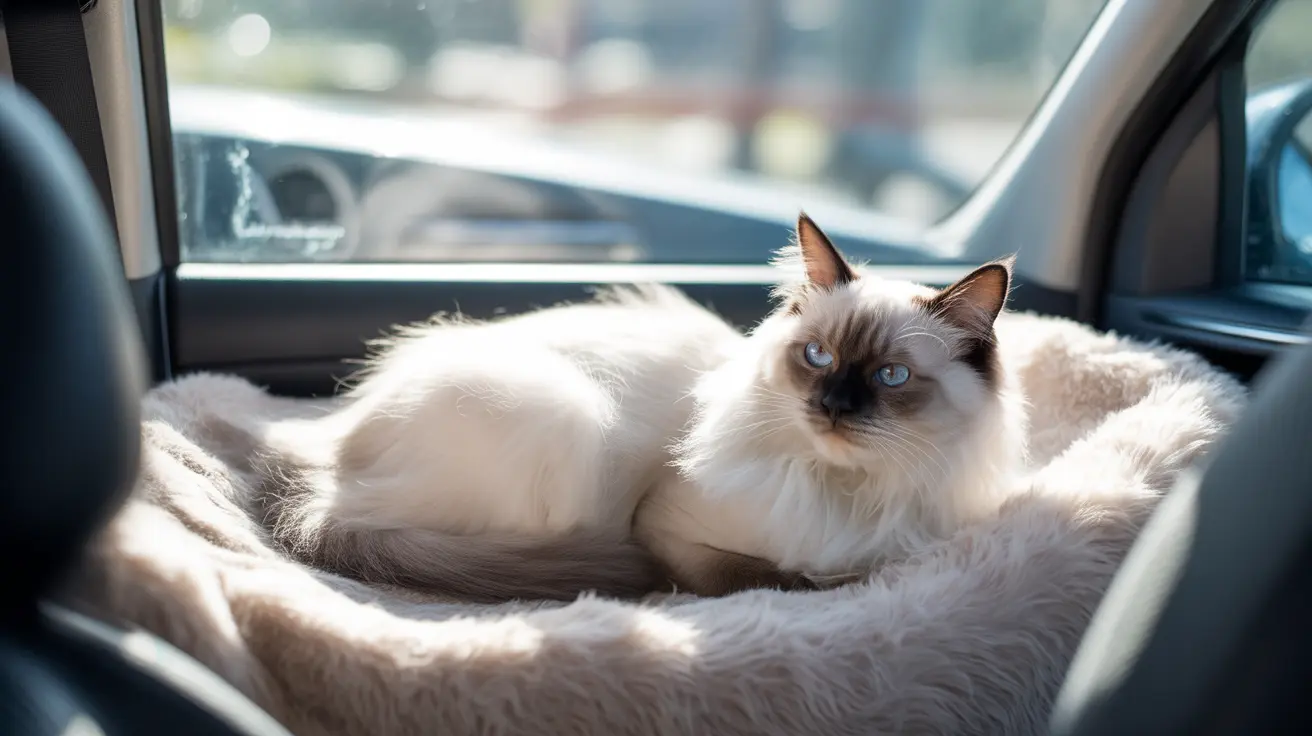The Complete Guide to Stress-Free Car Travel with Cats: Tips for a Safe and Comfortable Journey
Traveling with your feline companion doesn't have to be a stressful ordeal for either of you. While cats are naturally territorial creatures who prefer familiar environments and established routines, proper preparation and the right approach can transform car travel from a dreaded experience into a manageable, even enjoyable adventure. Whether you're heading to the vet, moving to a new home, or embarking on a longer journey, understanding how to create a calm, secure environment for your cat during car travel is essential for their wellbeing and your peace of mind.
The key to successful stress-free car travel with cats lies in advance preparation, choosing the right equipment, and implementing proven techniques that work with your cat's natural instincts rather than against them. By following evidence-based strategies and taking the time to properly acclimate your pet to the travel process, you can significantly reduce anxiety and ensure a safer, more comfortable journey for everyone involved.
Choosing the Right Cat Carrier for Car Travel
The foundation of stress-free car travel with cats begins with selecting an appropriate carrier. Your cat will spend the majority of the journey inside their carrier, making this choice crucial for their comfort and safety. The ideal carrier should be spacious enough for your cat to stand up, turn around, stretch, and curl up comfortably. This freedom of movement is essential for reducing claustrophobia and allowing your cat to find their preferred position during the journey.
Top-opening carriers are strongly recommended over front-opening models for several important reasons. When you need to place your cat in the carrier or remove them, a top-opening design allows for gentler, less stressful access. Your cat won't feel cornered or trapped, as they might with front-opening carriers that require them to be pushed or pulled through a narrow opening. Additionally, avoid wicker baskets entirely, as they are difficult to clean thoroughly and may harbor odors or bacteria that could stress your cat.
Plastic carriers with good ventilation are generally the best choice for car travel. They're easy to clean, durable, and provide a secure environment. Ensure the carrier has adequate ventilation on multiple sides and secure latching mechanisms that won't accidentally open during travel. The carrier should also fit securely in your vehicle without excessive movement when properly positioned.
Creating a Calming Environment with Scents and Setup
Cats rely heavily on their sense of smell to navigate their world, making scent management a critical component of stress-free car travel. Before using any carrier, ensure it's completely free from unfamiliar scents, especially those from other animals. Even if a carrier appears clean, residual odors can cause significant anxiety in your cat.
Pheromone sprays designed specifically for cats can be incredibly effective in creating a calming environment. Apply these sprays to the carrier, bedding, and even your hands before handling your cat. These synthetic pheromones mimic the natural calming scents that mother cats produce, helping to reduce anxiety and promote relaxation during travel.
Consider covering the carrier with a breathable blanket or towel to create a den-like environment. This covering serves multiple purposes: it reduces visual stimuli that might stress your cat, creates a sense of security and enclosure, and helps muffle potentially frightening sounds from the car and outside environment. Ensure the covering doesn't block ventilation holes and can be easily removed if your cat becomes too warm.
Gradual Acclimation: Building Positive Carrier Associations
One of the most crucial steps in ensuring stress-free car travel with cats is gradually acclimating your pet to their carrier well before any planned journey. This process should begin weeks before travel, never on the day of departure when stress levels are already elevated. The goal is to transform the carrier from an object associated with negative experiences (like vet visits) into a familiar, comfortable space.
Start by placing the carrier in a common area of your home with the door open. Put your cat's favorite blanket, toy, or treat inside to create positive associations. Some cats may naturally investigate and even choose to sleep in the carrier if it's presented as an additional comfortable sleeping spot rather than a transport necessity.
Gradually increase your cat's exposure to the carrier by feeding them meals nearby, then eventually inside the carrier with the door open. Once your cat is comfortable entering and exiting freely, practice short periods with the door closed, always followed by treats and positive reinforcement. This systematic desensitization helps prevent the panic and resistance that many cats display when suddenly confined to an unfamiliar carrier.
Pre-Travel Preparation and Timing Strategies
Never attempt to place your cat in their carrier under time pressure or when you're feeling stressed, as cats are highly sensitive to human emotions and energy. Plan veterinary appointments or travel with adequate buffer time, allowing for a calm, unhurried process. If you're running late or feeling anxious, your cat will likely mirror these emotions and become more resistant to entering the carrier.
On travel day, consider withholding breakfast to reduce the risk of nausea and vomiting during the journey. However, ensure your cat has access to water before departure. Line the carrier with absorbent potty pads and pack cleanup supplies in case of accidents. Include familiar items like your cat's favorite blanket or toy to provide comfort and familiar scents during the journey.
Prepare a comprehensive travel kit that includes your cat's regular food, water from home (sudden changes in water can cause digestive upset), any necessary medications, vaccination records, and a portable litter box for longer journeys. Having everything prepared in advance reduces last-minute stress for both you and your cat.
Safe Car Positioning and Security Measures
Proper positioning and securing of your cat's carrier in the vehicle is essential for safety during car travel. The carrier should be positioned securely to prevent sliding, tipping, or excessive movement during turns, stops, or sudden movements. Ideal placement is on the car floor between your legs (if you're a passenger) or secured on a seat with seat belts.
Never transport your cat in the trunk of a vehicle, as this area lacks proper ventilation and climate control. Similarly, never allow your cat to roam freely in the car while the vehicle is in motion, regardless of how well-behaved they typically are. Even the most docile cat can become frightened by sudden noises or movements and potentially interfere with driving or escape through open windows or doors.
For longer journeys, plan regular breaks to allow your cat to drink water and stretch if they're comfortable doing so. During stops, always ensure your cat cannot escape from the vehicle. Some cats may be comfortable with a harness and leash for brief supervised breaks, while others will prefer to remain in their carrier throughout the journey.
Managing Sound and Environmental Factors
The auditory environment during car travel significantly impacts your cat's stress levels. Avoid playing loud music or talk radio, as sudden sounds, volume changes, or unfamiliar voices can increase anxiety. Instead, consider playing soft classical music or specialized recordings designed to calm animals. These sounds can help mask potentially frightening noises from traffic, construction, or other environmental sources.
Maintain a comfortable temperature in the vehicle throughout the journey. Cats can overheat quickly, especially in carriers with limited airflow. Never leave your cat unattended in a car, particularly in warm weather, as temperatures can rise to dangerous levels within minutes. Even with windows cracked, a car can become a deadly environment for pets in surprisingly short periods.
Be mindful of your own behavior and emotional state during travel. Cats are extremely sensitive to their owner's stress and anxiety. If you remain calm and speak to your cat in soothing tones throughout the journey, they're more likely to stay relaxed as well.
Essential Travel Kit Items for Cat Car Trips
A well-prepared travel kit is crucial for stress-free car travel with cats, especially on longer journeys. Your kit should include enough of your cat's regular food for the entire trip plus extra in case of delays. Sudden dietary changes can cause digestive upset, so avoid introducing new foods during travel. Include water from home when possible, as different mineral contents in water from various locations can sometimes cause stomach sensitivity.
Pack a portable litter box with familiar litter for longer trips. Some cats will hold their bladder and bowels for several hours during car travel, but others may need access to a litter box. Seamless, portable travel litter boxes are specifically designed for this purpose and can be invaluable for extended journeys.
Include cleanup supplies such as paper towels, wet wipes, and plastic bags for any accidents or spills. Pack your cat's medications if they require daily treatments, along with a copy of their medical records and vaccination certificates. A recent photo of your cat and your veterinarian's contact information should also be easily accessible in case of emergencies.
Recognizing and Responding to Travel Stress
Understanding the signs of travel stress in cats allows you to respond appropriately and potentially prevent more serious anxiety responses. Common indicators include excessive vocalization (meowing, crying, or yowling), panting, drooling, vomiting, or attempts to escape the carrier. Some cats may become very still and quiet when stressed, while others may pace or seem restless within their carrier.
If your cat shows signs of severe distress, find a safe place to pull over and assess the situation. Sometimes simply talking to your cat in calm, reassuring tones can help. Check that the carrier isn't too warm and ensure adequate ventilation. For cats experiencing motion sickness, stopping for a brief break may help, though avoid opening the carrier unless you're in a completely secure environment.
For cats with extreme travel anxiety, consult with your veterinarian before the journey about possible sedation options. However, sedatives should only be used as a last resort and must be administered according to veterinary instructions with proper timing. Never use human medications or over-the-counter remedies without veterinary approval, as many substances safe for humans are toxic to cats.
Post-Travel Adjustment and Re-Integration
After arriving at your destination, give your cat adequate time to adjust to their new environment, even if it's just a return home from a vet visit. Cats may need time to process the experience and return to their normal behavior patterns. Allow them to exit the carrier voluntarily when possible, rather than forcing them out immediately.
If you have multiple pets at home, be aware that your traveling cat may smell different due to exposure to unfamiliar scents during the journey. This can sometimes trigger aggressive responses from other pets who no longer recognize their companion's familiar scent. Consider keeping the traveling cat separated from other pets for a short period until they've had time to groom themselves and re-establish familiar scents.
Monitor your cat for several hours after travel for any signs of continued stress or illness. While most cats recover quickly from car travel, some may experience lingering effects such as loss of appetite, hiding behavior, or changes in bathroom habits. These typically resolve within 24-48 hours, but persistent symptoms warrant veterinary attention.
Frequently Asked Questions
- How long can a cat stay in a carrier during car travel?
Most healthy adult cats can stay in a properly ventilated carrier for 4-6 hours without needing a break. However, for journeys longer than 2-3 hours, it's recommended to offer water and check on your cat during stops. Kittens, senior cats, or those with health conditions may need more frequent breaks.
- Should I feed my cat before car travel?
It's generally recommended to withhold food for 2-4 hours before travel to reduce the risk of nausea and vomiting. However, ensure your cat has access to water before departure and during longer journeys. Never withhold food for more than 12 hours for adult cats or 6 hours for kittens.
- Can I use a sedative to calm my anxious cat during car travel?
Sedatives should only be used as a last resort and must be prescribed and administered according to veterinary instructions. Never use human medications or over-the-counter remedies, as many are toxic to cats. Consult your veterinarian well before travel to discuss options if your cat experiences extreme anxiety.
- What type of carrier is best for car travel with cats?
A hard-sided plastic carrier with top-opening access is generally best for car travel. It should be large enough for your cat to stand, turn around, and lie down comfortably. Avoid wicker baskets or carriers that only open from the front, as these can be more stressful and difficult to clean.
- How can I help my cat get used to car travel?
Start by making the carrier a positive space in your home weeks before travel. Feed your cat meals near or in the carrier, place comfortable bedding inside, and gradually increase time spent in the closed carrier. Take short practice drives, starting with just sitting in the parked car with the engine running, then progressing to brief trips around the block.
- Is it safe to let my cat roam freely in the car during travel?
No, it's never safe to allow cats to roam freely in a moving vehicle. Even calm, well-behaved cats can become frightened and interfere with driving or escape through open doors or windows. Always keep your cat secured in their carrier or, for very short distances and with a passenger present, in a proper pet harness attached to a seat belt.
- What should I do if my cat gets car sick during travel?
If your cat shows signs of motion sickness (drooling, vomiting, excessive panting), find a safe place to stop and allow them to rest. Ensure adequate ventilation in the carrier and avoid feeding for several hours before future trips. If car sickness persists, consult your veterinarian about anti-nausea medications or other solutions.
Conclusion
Achieving stress-free car travel with cats is entirely possible with proper preparation, patience, and the right approach. The key lies in understanding your cat's natural instincts and working with them rather than against them. By choosing appropriate equipment, creating positive associations with the carrier, and implementing calming strategies, you can transform what many consider a stressful ordeal into a manageable experience.
Remember that every cat is different, and what works for one may not work for another. Be patient with the acclimation process and don't hesitate to consult with your veterinarian if your cat experiences severe travel anxiety. With time and consistent positive experiences, most cats can learn to tolerate and even become comfortable with car travel, opening up new possibilities for adventures together and ensuring that necessary trips to the vet or other destinations are less stressful for everyone involved.






